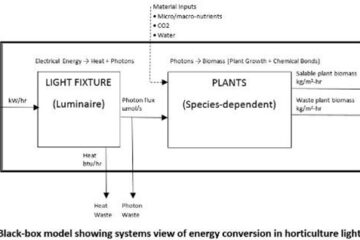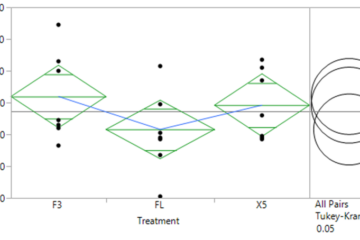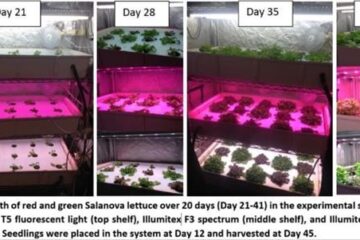The physiological differences and chlorophyll content of lettuce grown under three different light treatments (fluorescent, F3 LED, and X5 LED) were investigated. These experiments were conducted in a vertical growing system on two lettuce varieties (Red Oakleaf and Green Butter Salanova) under the three different light treatments with all other environmental parameters (including wattage) kept constant. The fluorescent-grown lettuce had thinner leafs and cores and less leaf color (anthocyanin) than the LED-grown lettuce. Chlorophyll extraction confirmed that chlorophyll a and b to dry weight increased, and the ratio of chlorophyll a/b decreased in the fluorescent-grown lettuce. These results are an indication of thinner cell walls and enlargement of photosynthetic antennae systems in the fluorescent-grown lettuce compared to the LED-grown lettuce. The difference in chlorophyll a/b ratio for red and green lettuce under the different LED spectrums suggest green lettuce grew equally well under both LED spectrums and red lettuce favored the F3 over the X5 spectrum.
Table of Contents
1. Introduction
2. Materials and Methods
3. Results
4. Discussion
5. References
1. Introduction
Indoor vertical farmers have many lighting choices when it comes to horticulture lighting. LEDs represent the most efficient means of providing photons but there is still debate on how the use of LEDs vs. legacy lighting affects growth and productivity of different plant species. The experimental set-up and results outlined in this report provide data in order to clarify the effects of different lighting types and spectrum delivery on growth and development of specific crop plants. This information will allow indoor farmers to take the first step in making a smart decision regarding LED lighting systems for specific applications.
2. Materials and Methods
Please refer to a previous article, “Increased Growth and Marketability of Two Lettuce Varieties Due to LED vs. Fluorescent Lighting,” for the materials and experimental set-up used in this experiment and to the video taken on the day of harvest:
The pigment analysis was conducted by freeze-drying the leaf tissue in liquid nitrogen, then grinding the biomass in a mortar and pestle into a fine powder. Next, 0.5 g of the power was placed in a glass homogenizer with 5 ml of N,N-dimethylformamide (DMF). The tissue was homogenized by hand for approximately 5 min and vortexed. The liquid solvent was poured off and re-homogenized with new solvent until no pigment remained in the tissue sample. The collected solvent was then filtered through a PTFE capsule filter. Figure 1 shows photos of the laboratory pigment extractions.
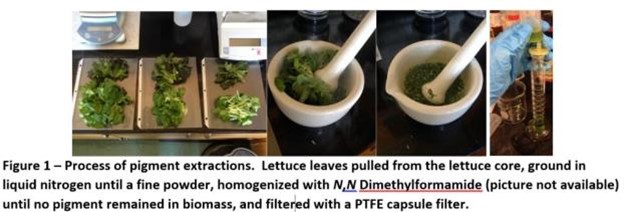
Pigment extraction samples were measured on a dual beam spectrophotometer using DMF as the blank. The following equations were used to calculate chlorophyll a and chlorophyll b in µg/ml (Inskeep et al.):
Chl a=12.7(A664.5) – 2.79(A647)
Chl b=20.7(A647) – 4.62(A664.5)
Where,
A647=Absorbance at 647 nm
A664.5=Absorbance at 664.5 nm
3. Results
Visual Inspection
One representative sample was subjected to pigment analysis from each treatment type (fluorescent, F3 LED, and X5 LED) and lettuce variety (red and green), for a total of six plants. Table 1 shows comparisons of the samples by light treatment, their root systems, and the underside after being cut from the base of the grow plug.
Compared to the LED light treatments, the fluorescent light treatment resulted in long, thin leaves, with much space in-between leafs (as evident from underside). The fluorescent-grown lettuce also had shorter root systems and less red pigment (anthocyanin) in the red lettuce.

Between the LED-grown lettuces there was not much noticeable difference in leaf shape, both had wide leaves that felt thicker to the touch compared to the fluorescent leafs. The red lettuce had longer root systems in both LED treatments than the green lettuce. In order to investigate the core of the lettuce heads, the leaves were picked away from the core and the cores are shown in Figure 2. The cores of the fluorescent-grown lettuce were much thinner and longer than the LED treatments, whereas the LED cores were thick, with closely stacked branches.
Chlorophyll Analysis
The leaves for each sample plant were analyzed for chlorophyll a and b content. Figure 3 shows the amount of chlorophyll a and b for the six samples. Based on these results, the red varieties all had more chlorophyll a and b than their corresponding green varieties. Also, the fluorescent lights resulted in more chlorophyll a and b than the LED treatments.
In order to understand better the photosynthetic physiology of the plants, the ratio of chlorophyll a and b were compared and are shown in Figure 4. The fluorescent lights had the lowest ratios, followed by red lettuce under X5 LED.
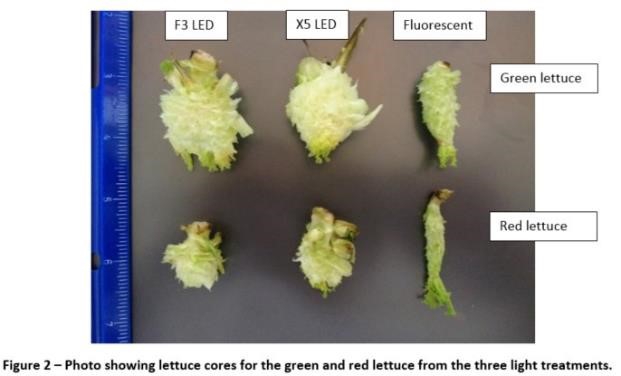
4. Discussion
This experiment outlined the impact in morphology (shape) and chlorophyll content of two lettuce varieties due to differences in lighting conditions. The three light sources (fluorescent, Illumitex F3 LED, Illumitex X5 LED) were matched to use the same amount of wattage. With all other environmental parameters equal, the lettuce grown under LED lights was larger and more colorful than the lettuce grown under fluorescent lights.
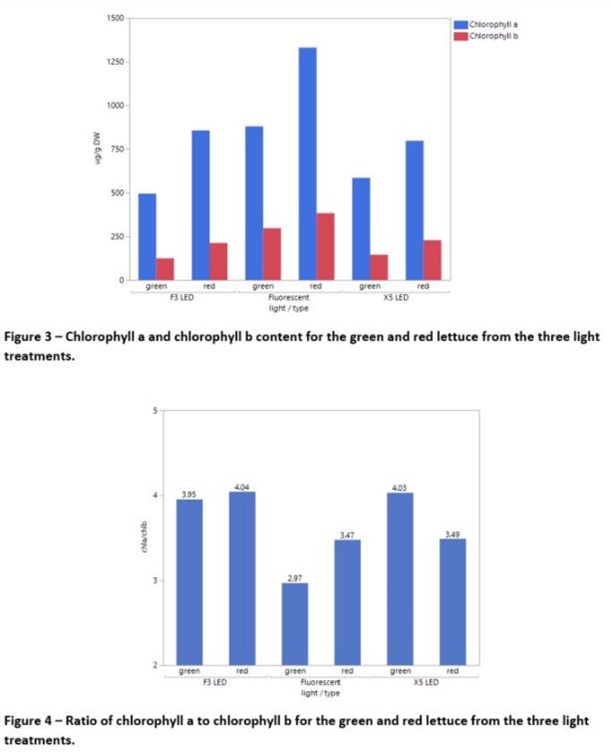
Pigment analysis determined that the fluorescent lights had the highest concentration of chlorophyll a and b per gram of dry weight. Chlorophyll a and b are photosynthetic pigments located in the photosystems of the chloroplast thylakoid membranes. A likely reason the chlorophyll per weight was less for the LED-grown lettuce is because of differences in cell mass. Leaves grown in more light tend to have thicker cell walls and higher dry weight. This results in decreased amounts of pigment per dry weight for leaves that are healthy and not light-limited. In this experiment difference in leaf thickness and weight were observed by taste-testers in previously reported data (link). The difference in leaf (photosynthetic area) size can be seen in the visual inspection photos. Within each treatment the red lettuce was smaller in weight and core size to the corresponding green lettuce. Similar to the differences observed for the light treatments, this decrease in mass would cause the chlorophyll to mass ratio to increase in the red lettuce varieties.
The ratio of chlorophyll a/b decreased in the fluorescent treatment compared to the LED light treatments. Since chlorophyll b is an accessory pigment, this indicates a larger antennae system and more chlorophyll b needed to permit further trapping of photons, a response that occurs in shade or light-limiting conditions. In the F3 LED treatment the ratio is constant, indicating that the photosystems seem to be consistent. In the X5 LED treatment the green lettuce ratio is similar to the F3 LED lettuce, however, the red lettuce has a lower chlorophyll a/b ratio. In the fluorescent-grown lettuce, the green lettuce has a lower chlorophyll a/b ratio than the red lettuce. These changes to photosystem antennae structure suggests that green lettuce is suitable under the F3 spectrum and X5 spectrum equally but poorly grown under the fluorescent spectrum. Whereas the red lettuce does best under F3 spectrum compared to X5 and fluorescent.
Upon visual inspection, the fluorescent lights led to lettuce leaves that were more fragile, spindly, and narrow than their LED-grown lettuce counterparts. Also, the cores of the LED-grown lettuce were thin and long compared to the stacked cores of the LED-grown lettuce. This is the photomorphogenic response of plants stretching towards the light, and could be due to either less light being emitted from the fluorescent light or to the differences in light quality (spectrum).
In conclusion, the physiological inspection of two lettuce types showed a clear difference in fluorescent-grown lettuce compared to the LED-grown lettuce. Differences in chlorophyll content and ratio showed potential suitability of particular lettuce types to spectrum quality. For this experiment, the F3 LED spectrum resulted in red and green lettuces growing with similar photosynthetic compositions and the healthiest looking leaves. Of the two LEDs, the F3 is the recommended choice in vertical farming for growing both red and green lettuce.
5. References
- Knight, Rebecca. “Increased Growth and Marketability of Two Lettuce Varieties Due to LED vs. Fluorescent Lighting,”
- Inskeep WP, Bloom PR. Extinction Coefficients of Chlorophyll a and b in N,N-Dimethylformamide and 80% Acetone . Plant Physiology. 1985. 77(2):483-485.
- Vicaş SI, Vasile L, Stelian P, Bandici GE. Chlorophyll and carotenoids pigments from mistletoe (Viscum album) leaves using different solvents. Analele Universităţii din Oradea – Fascicula Biologie. 2010. Tom. XVII, Issue: 2, 2010, pp. 213-218.
- Illumitex Lighting Experiment: https://www.youtube.com/watch?v=z4oqne0_5v0 .
